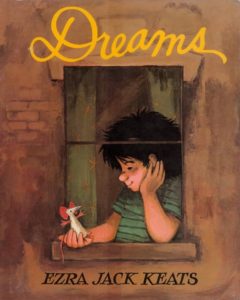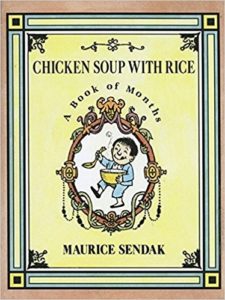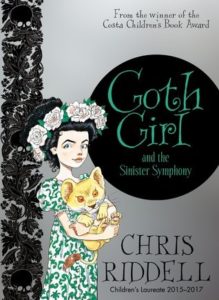| Recommended Reads | Download PDF |
Keats, Ezra Jack (1974). Dreams.
New York: Macmillan.
Recommended by Annett Kaminski
Dreams by Ezra Jack Keats was lying a bit forlorn in an old box at a library book sale when its cover caught my eye. I immediately knew I had found a treasure. In the hustle and bustle of bargain-hunting book fans, time just seemed to stop as the story of a young boy unfolded. Roberto, proud of the paper mouse he made at school, leaves it sitting outside the window and goes to bed. As everyone else in the neighbourhood starts dreaming, Roberto is lying in bed awake. Looking out of the window, he sees a dog chasing his neighbour’s cat. He is worried and accidentally touches his paper mouse so that it falls from the window sill. Its shadows become bigger and ghostlier on its way down to the pavement, scaring away the dog, and Roberto can finally fall asleep.
In simple, yet vivid words, a timeless story is told that young learners can relate to. After all, they too might find it hard to settle down at night and worry about their pet’s well-being. Teachers can therefore expect their learners to show genuine interest in the storyline, in classic picturebook format with 16 dramatic and powerful double spreads that capture your learners’ attention and draw them into the narrative. In the illustrations, the simple straight lines of an apartment block immediately evoke urban life that many children are familiar with, and contrast with the curvy, marbled patterns of the sky that depict dusk, night and dawn. Later, the illustrations create the illusion of standing next to [End of Page 49] Roberto looking out onto the street with him. The images do not only complement the text, they also enrich it and can stimulate further classroom talk about Roberto’s neighbours, for example, who can be seen behind the windows, but are not mentioned in the verbal text. This is a forty-year-old picturebook which has lost nothing of its vivacity and might also inspire your learners to draw pictures about their own neighbourhood, which can then be talked about in the classroom.
| Annett Kaminski (PhD) works as a Research Assistant at the University of Koblenz-Landau in Germany. She teaches language classes, seminars on British culture, children’s literature and teaching methodology as part of the undergraduate and postgraduate degree programmes for future primary schoolteachers. In her research, she investigates how multimodal features in picturebooks, stories, songs and chants contribute to FL acquisition. |
Wild, Margaret & Brooks, Ron (2000). Fox.
Crows Nest: Allen & Unwin.
Recommended by Maria C. Valeije
Fox, written by Margaret Wild and illustrated by Ron Brooks, is a multiple award-winning picturebook, which has become a contemporary classic, deserving a special place in every classroom library. Dog saves Magpie in a forest fire, but both are hurt – Dog loses an eye and Magpie injures a wing and can no longer fly. An unusual bond is celebrated when the two creatures help each other, but their friendship is threatened upon the arrival of a new friend, Fox. Fable-like, the story is [End of Page 50] simple, but full of feelings and sensations that perfectly connect with teenage concerns about friendship and being socially accepted by peers. From the cover to the last page of this book, the clever composition of elements, intense use of colour and expressive texture in every illustration, tell a parallel and complementary story to the minimalistic and poetic text, written by Margaret Wild. This is a unique book that will not leave any reader indifferent to its deeply moving story.
Fox has the potential to be a powerful tool in the hands of any EFL teacher who is looking for different ways to engage teenagers in authentic English reading and lure them into the world of picturebooks. It allows for an intense study of the use of visual language in picturebooks thanks to Ron Brooks’ outstanding illustrations. Fox will also inspire class discussions as it encourages students to empathize with the characters of the story and respond in a personal and creative way to the shared reading. Later, language development can be included around nature, feelings and sensations, as well as research into Australian flora and fauna. Finally, the last scene leaves readers wondering, so students can try their hand at creative writing, composing their own ending.
| Maria Concepción Valeije García is a secondary school EFL teacher in Spain. Her research interests are language and literacy development in the second language, visual and critical literacy and creative writing. She is currently writing her Master’s thesis on how to use picturebooks to promote critical and creative thinking among secondary students. [End of Page 51] |
Sendak, Maurice (1962). Chicken Soup with Rice.
New York: HarperCollins.
Recommended by Anneta Sadowska-Martyka
Chicken Soup with Rice is a rhyming book that employs a little boy’s love for soup to teach children the months of the year. Using a poem for each month, it features Sendak’s imaginative drawings alongside the lyrical verses. Sendak uses simple sketches, partly coloured in blue, yellow and green, to mirror the rhyme’s content. His charming artwork may seem a bit pale for children brought up on sophisticated graphics of modern computer animations, but there is something disarming about the quirky rhymes and their visual interpretations – a robin in a chef’s hat makes chicken soup in her nest, a whale spouts chicken soup, the boy floats on a crocodile down the soupy Nile, and a Christmas tree is decorated with bowls of chicken soup! These illustrations, so different from a typical modern picturebook, help focus students’ attention as they listen to the silly verses. This is definitely the strong point of the sharing of this story and after a few readings, the phrase ‘chicken soup with rice’ becomes a cheering mantra.
There is something magical about chicken soup, known to most children, for in many countries it is considered a comfort food and believed to be a remedy that will cure ailments, especially successful in cases of the flu. My North American kindergarten friends use Chicken Soup with Rice to teach months of the year and different calendars. In Poland, I have used this picturebook with my 8-year-old EFL students to talk about favourite foods, preparing a little project suggesting reasons to eat this food all year round. Finally, Carole King sings Chicken Soup with Rice, which beautifully reflects the rhythm and rhyme of the verses, and catches the music that one can sense between the pages as it is [End of Page 52] read aloud – https://www.youtube.com/watch?v=sNBzJlpwChU. It is an excellent extension to the sharing of this classic picturebook.
| Anneta Sadowska-Martyka is a psychologist, teacher trainer and a primary English teacher in Warsaw, working with children aged 6-12. In 2008, she was awarded The European Language Label for her programme ‘Sharing Stories about Cooperation’ based around picturebooks. Anneta is currently working on developing a course for teenagers using picturebooks to foster social and emotional intelligence. |
Riddell, Chris (2017). Goth Girl and the Sinister Symphony.
London: Macmillan.
Recommended by Susanne Reichl
Book 4 in Children’s Laureate Chris Riddell’s Goth Girl series is just as delightful as its three predecessors. Ada Goth, its teenage protagonist, lives in Ghastly-Gorm Hall, together with an assortment of quirky characters, with whom she solves all kinds of mysteries and puzzles. The setting is Gothic in the true sense of the word, as it involves a rambling country mansion with turrets and secret passages and an assortment of creepy characters including a vampire governess. In this part of the series, Ada’s widowed father organises a musical festival at Ghastly-Gorm Hall, which involves the country’s most famous musicians.
The unique quality of this elaborate series comes from its tight interaction of words and images: Riddell’s characters are allusions to canonical or popular literature and culture, and this is manifest in their names and in the illustrations, which are often [End of Page 53] caricatures of internationally well-known people, such as a very recognisable ‘Donald Ear-Trumpet’, who has orange skin and is hit by a rotten tomato. Among the participants of the musical festival are the Ladies of G.A.G.G.A., ‘the General Association of the Garden Garland Assemblers’, and the B.A.D. Boys: ‘Bards and Druids, […] a band of garden hermits’ (55). The finale of the festival is the appearance of Europe’s foremost composers: Mr Joseph Haydn-Seek, Franz Sherbert, Felix Meddlesome, and Ludwig van Beetlebrow, but the narrative is brought to a conclusion by the charming Taylor Extremely-Swift, who becomes Ada’s new step-mother. The romping fun is a result of Riddell’s exuberant and detailed illustrations, which support the fast action and slapstick moments.
This beautiful book works well with fairly advanced and ambitious learners who have an interest in and some knowledge of British literature and culture. It lends itself to a competitive spotting of references and allusions, and could work well as the starting point of a webquest. The illustrations of Ada’s impressive wardrobe or the characters’ crazy hairstyles can be used for vocabulary practice, and the characters’ often complex facial expressions and body language would make a good starting point for describing emotions and training those neglected adjectives. In an extensive reading context, the book is likely to become a favourite with girls, who will love the clever and endearing heroine and her friends.
| Susanne Reichl is Professor of contemporary English literature at the University of Vienna in Austria. Her research interests include children’s and young adult literature, Black and Asian British literature, time travel fiction and the teaching of literature. Her latest book is a co-edited a volume on teacher education, Theory and Practice in Teacher Education: Bridging the Gap (2012). [End of Page 54] |





